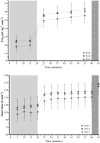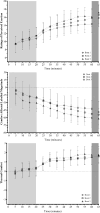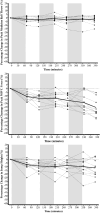Metabolic, cardiovascular, neuromuscular and perceptual responses to repeated military-specific load carriage treadmill simulations
- PMID: 38886977
- PMCID: PMC11295085
- DOI: 10.1002/ejsc.12154
Metabolic, cardiovascular, neuromuscular and perceptual responses to repeated military-specific load carriage treadmill simulations
Abstract
Bouts of military load carriage are rarely completed in isolation; however, limited research has investigated the physiological responses to repeated load carriage tasks. Twelve civilian men (age, 28 ± 8 years; stature, 185.6 ± 5.8 cm; body mass 84.3 ± 11.1 kg and maximal oxygen uptake, 51.5 ± 6.4 mL·kg-1 min-1) attended the laboratory on two occasions to undertake a familiarisation and an experimental session. Following their familiarisation session, participants completed three bouts of a fast load carriage protocol (FLCP; ∼65 min), carrying 25 kg, interspersed with a 65-min recovery period. Physiological strain (oxygen uptake [V̇O2] and heart rate [HR]) was assessed during the FLCP bouts, and physical performance assessments (weighted counter-movement jump [wCMJ], maximal isometric voluntary contraction of the quadriceps [MIVC] and seated medicine ball throw [SMBT]) was measured pre and post each FLCP bout. A main effect for bout and measurement time was evident for V̇O2 and HR (both p < 0.001 and Ѡ2 = 0.103-0.816). There was no likely change in SMBT distance (p = 0.201 and Ѡ2 = 0.004), but MIVC peak force reduced by approximately 25% across measurement points (p < 0.001 and Ѡ2 = 0.133). A mean percentage change of approximately -12% from initial values was also evident for peak wCMJ height (p = 0.001 and Ѡ2 = 0.028). Collectively, these data demonstrate that repeated FLCP bouts result in an elevated physiological strain for each successive bout, along with a substantial reduction in lower body power (wCMJ and MIVC). Therefore, future research should investigate possible mitigation strategies to maintain role-related capability.
Keywords: combatant; military personnel; occupational physiology; physical functional performance; physiological stress.
© 2024 The Author(s). European Journal of Sport Science published by Wiley‐VCH GmbH on behalf of European College of Sport Science.
Conflict of interest statement
The authors declare that there are no conflicts of interest/competing interests.
Figures



Similar articles
-
Cognitive, Psychophysiological, and Perceptual Responses to a Repeated Military-Specific Load Carriage Treadmill Simulation.Hum Factors. 2024 Oct;66(10):2379-2392. doi: 10.1177/00187208231214216. Epub 2023 Nov 28. Hum Factors. 2024. PMID: 38018153 Free PMC article.
-
The test-retest reliability of physiological and perceptual responses during treadmill load carriage.Eur J Appl Physiol. 2024 Jul;124(7):2093-2100. doi: 10.1007/s00421-024-05435-0. Epub 2024 Feb 28. Eur J Appl Physiol. 2024. PMID: 38418703 Free PMC article.
-
Physiological Responses of Female Load Carriage Improves after 10 Weeks of Training.Med Sci Sports Exerc. 2020 Aug;52(8):1763-1769. doi: 10.1249/MSS.0000000000002321. Med Sci Sports Exerc. 2020. PMID: 32102055
-
No physiological or biomechanical sex-by-load interactions during treadmill-based load carriage.Ergonomics. 2020 Sep;63(9):1175-1181. doi: 10.1080/00140139.2020.1772379. Epub 2020 Jun 3. Ergonomics. 2020. PMID: 32441225
-
Sex differences in neuromuscular fatigability in response to load carriage in the field in British Army recruits.J Sci Med Sport. 2018 Jun;21(6):591-595. doi: 10.1016/j.jsams.2017.10.018. Epub 2017 Oct 23. J Sci Med Sport. 2018. PMID: 29100827
References
-
- Armstrong, N. C. , Smith S. J. R., Risius D., Doyle D., Wardle S. L., Greeves J. P., House J. R., Tipton M., and Lomax M., and D. D.‐B. M., & 2022, U . 2022. “Cognitive Performance of Military Men and Women during Prolonged Load Carriage.” Militaryhealth.Bmj.Com 169(1): 37–45. 10.1136/bmjmilitary-2021-002000. - DOI - PMC - PubMed
-
- ASHRAE Standard . 1992. Standard 55‐1992, Thermal Environmental Conditions for Human Occupancy. American Society of Heating, Refrigerating and Air Conditioning Engineer.
-
- Bedford, T. 1936. “The Warmth Factor in Comfort at Work.” Rep. Industr. Hith. Res. Bd 76.
MeSH terms
LinkOut - more resources
Full Text Sources
Medical
Miscellaneous

